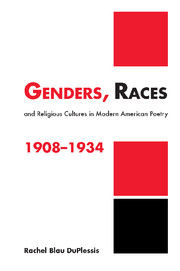Book contents
- Frontmatter
- Contents
- Acknowledgments
- 1 Entitled new: a social philology of modern American poetry
- 2 “Corpses of poesy”: modern poets consider some gender ideologies of lyric
- 3 “Seismic orgasm”: sexual intercourse, its modern representations and politics
- 4 “HOO, HOO, HOO”: some episodes in the construction of modern male whiteness
- 5 “Darken your speech”: racialized cultural work in black and white poets
- 6 “Wondering Jews”: melting-pots and mongrel thoughts
- Notes
- Works Cited
- Index
2 - “Corpses of poesy”: modern poets consider some gender ideologies of lyric
Published online by Cambridge University Press: 05 October 2009
- Frontmatter
- Contents
- Acknowledgments
- 1 Entitled new: a social philology of modern American poetry
- 2 “Corpses of poesy”: modern poets consider some gender ideologies of lyric
- 3 “Seismic orgasm”: sexual intercourse, its modern representations and politics
- 4 “HOO, HOO, HOO”: some episodes in the construction of modern male whiteness
- 5 “Darken your speech”: racialized cultural work in black and white poets
- 6 “Wondering Jews”: melting-pots and mongrel thoughts
- Notes
- Works Cited
- Index
Summary
Speaking in the 1950s of his 1916 poem “To a Young Housewife,” William Carlos Williams states “Whenever a man sees a beautiful woman it's an occasion for poetry – compensating beauty with beauty” (Williams 1986, 479). The genre “poetry” activates notable ideologies, myths and implicit narratives around sexuality and gender (Barthes 1972). Certainly poetry is always to be beautiful, and in these beauties linked to the beauties of Woman. Love, also, will be poetic. One of the key narratives that constructs traditional lyrics is “masculine, heterosexual desire,” with its interests in a silent, beautiful, distant female object of longing (Homans, 1985, 570). Inside the enounced, there is often a triangulated situation in the lyric: an overtly male “I,” speaking as if overheard in front of an unseen but postulated, loosely male “us” about a (Beloved) “she” (Grossman 1992, 227), articulating a homosocial triangle (Sedgwick 1985). This foundational cluster concerns voice (and the silent), power (of appropriation, envelopment, transcendence), pure beauty (not formation and culture), gaze (framing, specularity, fragmentation), and the sources of poetic matter – narratives of romance, of the sublime, scenes of inspiration, the muse as conduit (Vickers 1981). And as lyric poetry positions female figures in the feminine, it resists the possibility of effeminacy. While other aspects of lyric exist, this cluster contributes to the “political unconscious” of poetry in general, and of the romantic lyric in particular (Jameson 1981).
- Type
- Chapter
- Information
- Publisher: Cambridge University PressPrint publication year: 2001



